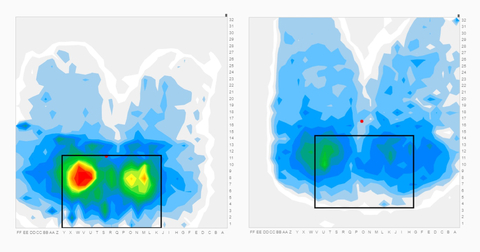ATF Medical has introduced its Pressure Injury Prevention and Intervention (PIPI) program to make sure that everyone involved in a workers’ compensation case has the information needed to prevent or properly treat pressure injuries, also known as wounds.
This press release features multimedia. View the full release here: https://www.businesswire.com/news/home/20220131005590/en/

ATF Medical uses pressure mapping to identify potential pressure injuries and to help prevent or treat wounds. The hot (red) colors on the left show the pressure is unevenly distributed in the current seated position, making it likely an injured worker will develop pressure-related injuries. The cool (blue) colors on the left show the seated position after the pressure is evenly distributed. (Image provided by Vista Medical.)
“There is a large body of information from credible nursing, rehabilitation, and equipment manufacturers about pressure injuries, but it is not all in one place, and not customized to the individual and circulated to all the providers who need it,” said ATF Medical’s Director of Rehab Technology Edwina Murphy, OTR, ATP.
The PIPI program reviews clients’ claims to identify injured workers at risk of developing pressure injuries and recommends ways to avoid them. When wounds already exist, ATF Medical’s professionals evaluate the injured worker’s condition and environment and uses pressure mapping systems for chairs and mattresses to detect pressure points.
“Pressure mapping helps identify a seat or mattress issue, often something that can be easily and inexpensively adjusted,” Murphy explained. “It’s an eye-opening educational tool. When injured people can see how relieving pressure affects the colors on the map, they’re more apt to comply with relief techniques and other self-management guidance.”
ATF Medical designs a customized pressure management program for the injured worker, synthesizing relevant treatment protocols, durable medical equipment data, and educational materials, and shares it with the injured worker, providers, and the claim representative. The report recommends solutions, such as pressure relief schedules to increase circulation or obtaining power-assisted tilt for a person who cannot move him or herself.
“Our program is designed to avoid and reduce costs through proper communication, coordination and accountability,” Murphy said. For more information on the ATF Medical Pressure Injury and Prevention Program, please contact Murphy at emurphy@atfmedical.com.
About ATF Medical
Headquartered in Newnan, Georgia, ATF Medical provides outcomes-driven and comprehensive medical equipment, supplies, and adaptive housing solutions for complex workers’ compensation claims throughout the United States. Specializing in catastrophic cases, ATF Medical oversees home modifications, educates injured employees, and stays involved for the life of the claim, maintaining, and servicing equipment, and monitoring the injured employee’s progress. Clients include workers’ compensation ancillary service providers, carriers, employers, and other payers. For more information, visit www.atfmedical.com or call 877-880-4283.
View source version on businesswire.com: https://www.businesswire.com/news/home/20220131005590/en/
























